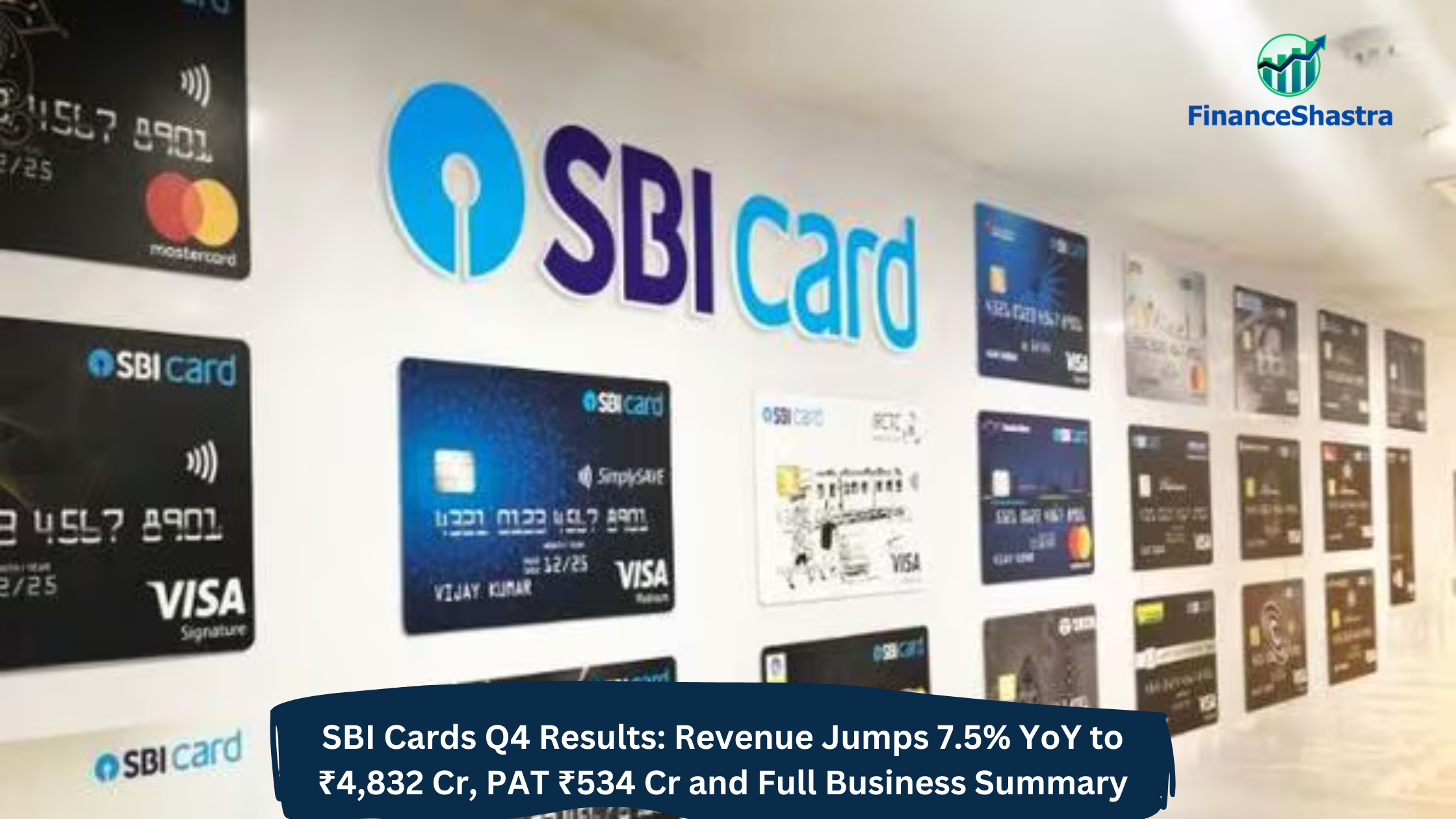SBI Cards Q4 Results: Revenue Jumps 7.5% YoY to ₹4,832 Cr, PAT ₹534 Cr and Full Business Summary
Business and Industry Overview:
SBI Cards & Payment Services Limited (SBI Card) is a big credit card company in India. It started in 1998. It was a joint venture between State Bank of India (SBI) and GE Capital. Later, SBI and The Carlyle Group bought GE’s part. Now SBI is the main owner. The head office is in Gurugram, Haryana. In March 2020, SBI Card became the first pure credit card company to list on Indian stock exchanges. SBI Card gives many types of credit cards. It has cards for lifestyle, shopping, travel, fuel, and business use. Some popular cards are SBI Card ELITE, SBI Card PRIME, SimplySAVE, and IRCTC SBI Card. The company also gives insurance services and EMI payment options. In April 2025, the share price of SBI Card is ₹867.55. The company’s market value is ₹82,535 crore. The price-to-earnings (P/E) ratio is 43.07. The dividend yield is 0.29%. The return on equity (ROE) is 14.8%. The debt-to-equity ratio is 3.26. Salila Pande is the Managing Director and CEO now. SBI Card is growing strong. It uses its big brand name, large network, and smart partnerships to grow more.
Latest Stock News:
SBI Cards & Payment Services shared its results for January to March 2025. The company’s profit fell by 19%. It made ₹534 crore profit this time. Last year, it made more. Profit fell because more people did not pay their loans. So, SBI Cards kept more money aside for bad loans. But total income increased. It became ₹4,832 crore. Interest income also grew. It reached ₹2,415 crore. Bad loans increased too. Gross bad loans became 3.08% of total loans. Last year, it was 2.76%. Net bad loans also rose to 1.46%. The company spent more money to cover these bad loans. For the full year, revenue grew by 39%. It became ₹15,460 crore. But profit fell by 20%. It became ₹1,920 crore. Profit margin fell from 22% to 12%. SBI Cards added more than 11 lakh new accounts in three months. Now, it has about 2.08 crore active credit cards. Customer spending increased by 11% compared to last year. After these results, SBI Cards’ share price fell by over 6%. Now, the stock price is around ₹867. Some experts cut their future price targets. They did this because bad loans increased and profits went down.
Segmental information:
1. Interest Income (Revolving Credit): SBI Cards earns money when customers do not pay their full credit card bill. Customers pay later with extra interest. SBI Cards charges interest on the unpaid amount. This is called revolving credit. This part gives a big amount of money to the company. It is a main source of income.
2. Fee-Based Income (Non-Interest Income): SBI Cards also earns money from different types of fees. It takes annual fees when someone gets a card. It charges late payment fees if customers pay late. It also charges fees when customers withdraw cash using the card. SBI Cards earns fees when customers move their balance to SBI Cards. It also earns money when people swipe their cards at shops and pay through machines.
3. Other Activities: SBI Cards earns money by selling insurance to its customers. It gives EMI loan options on big purchases. It allows balance transfer from other banks. It also sells extra services to its cardholders. These activities give some extra income but are smaller compared to the main income.
Subsidiary information:
SBI Cards & Payment Services does not have any big companies under it. It is mainly one company. The main owner is State Bank of India (SBI). SBI owns about 69.45% of SBI Cards. This means SBI is in charge. SBI Cards gets help from SBI. It uses SBI’s big customer base and name to grow. SBI Cards is the second biggest credit card company in India, after HDFC Bank.
Q4 Highlights:
- Profit: The profit dropped by 19% to ₹534 crore in the March quarter. This happened because more people did not pay back their loans on time.
- Revenue: The total income went up by 7.5% to ₹4,832 crore, from ₹4,475 crore last year.
- Interest Income: Interest income grew to ₹2,415 crore, from ₹2,139 crore last year.
- Bad Loans: The bad loans went up. Gross bad loans were 3.08% of total loans, up from 2.76% last year. Net bad loans were 1.46%, higher than 0.99% last year.
- Impairment Losses: The company had to set aside more money for bad loans. These losses increased by 32% from ₹944 crore to ₹1,245 crore.
- Full Year Results: For the whole year, profit dropped by 20% to ₹1,916 crore, down from ₹2,408 crore last year.
- Total Income (FY25): The total income for the whole year went up to ₹18,637 crore from ₹17,484 crore last year.
- Balance Sheet Size: The balance sheet size grew to ₹65,546 crore from ₹58,171 crore last year.
- Cards-in-Force: The number of credit cards issued increased by 10% compared to last year.
Financial Summary:
| Amount in ₹ Crore | Q4 FY24 | Q4 FY25 | FY24 | FY25 |
| Revenue | 4,348 | 4,674 | 16,986 | 18,072 |
| Expenses | 2,811 | 3,320 | 11,460 | 12,731 |
| EBITDA | 813 | 559 | 2,931 | 2,163 |
| OPM | 19% | 12% | 17% | 12% |
| Other Income | 127 | 158 | 498 | 565 |
| Net Profit | 662.00 | 534 | 2,408 | 1,916 |
| NPM | 15.23 | 11.42 | 14.18 | 10.60 |
| EPS | 6.97 | 5.61 | 25.32 | 20.14 |

